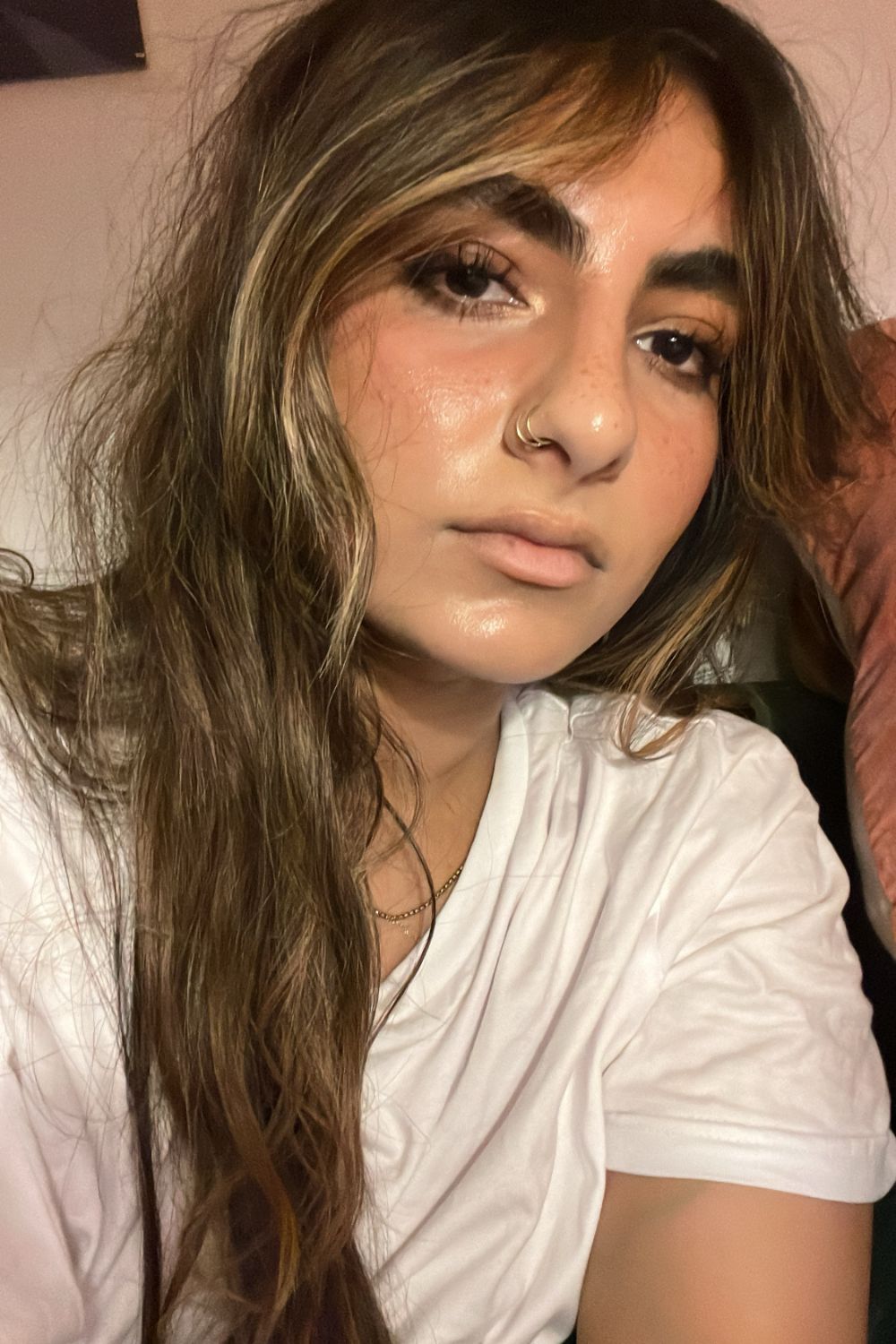Polynucleotide injections are the dark circle treatment of the moment—here's my tried and tested review
Can they really get rid of dark circles?


When I recently sat down next to Dr Ahmed El Muntasar (who you probably know as @TheAestheticsDoctor) at a dinner, I couldn’t help myself – I just had to ask him what he’d do to my face, if he had the chance. Back then (a whole three months ago), I was completely tweakment free and my face had never been touched with a needle.
“Probably a little something with your under-eyes,” he replied. I gasped—tear trough fillers? Quelle horreur! If you ask me to pick just one treatment that scares me the most, I will always reply with tear trough. “No, not necessarily,” he continued, unperturbed by my resistance. “You could always try polynucleotides," he said.

My under-eyes have always featured dark circles—a gift from my father—and they’re pretty much always slathered in layers of brightening concealer. They were indeed slathered when Dr Ahmed suggested polynucleotides, which is a testament to just how hollow they clearly were. Fast-forward a few months and I’m three sessions-deep into my polynucleotide treatments, and I have some thoughts to share.
What are polynucleotides?
Polynucleotides are biostimulators, which basically stimulate your own cells to produce collagen and elastin, which skin needs to look vibrant, bouncy and healthy. Think of polynucleotides as injectable skincare—you aren’t having something injected into your skin to change shape or plump up physically, rather you’re injecting fragmented bits of DNA that ask your own body to do the work.
“Polynucleotides are derived from fish DNA and act as signalling molecules that mirror human DNA,” says Dr Richard Devine of Carriages of Harley Street. “Essentially they communicate with our skin cells to increase the production of fibroblasts. These are the cells responsible for producing collagen and elastin for better skin elasticity and firmness. They also have an antioxidant effect which can help with pigmentation. This is a super popular treatment for the under eye as this is a common area of concern with few effective non-surgical treatment options.” So, if you’d like your under eyes to look brighter and refreshed with plumped fine lines, then polynucleotides could be for you.
How are polynucleotides different to Profhilo and Botox?
For any fellow first-timers, the world of aesthetic tweakments can be overwhelming. There are now so many different options—how do you know which to choose?
“Polynucleotides work more on a cellular level,” Dr Ahmed tells me. “Profhilo is basically just hyaluronic acid that's injected very superficially. It does nothing but hydrate your skin. Some say it can make you produce more collagen but that’s in very teeny, teeny, teeny, tiny amounts. Botox, however, basically stops muscle movement. So it doesn't rejuvenate like polynucleotides per se, it just paralyses,” she says. This lack of movement is what reduces the look of wrinkles.
Celebrity news, beauty, fashion advice, and fascinating features, delivered straight to your inbox!
“These treatments all act to improve the appearance of skin texture and fine lines but polynucleotides do it by boosting your body's ability to produce the components that make skin [appear] more youthful,” adds Dr Richard.
What happens during the procedure?
“Typically, the area treated is numbed with some lidocaine cream and then the serum is injected with tiny needles or with a cannula,” explains Dr Richard. “I prefer to use a cannula for the under-eye area as it's less traumatic, resulting in less bruising and swelling. For best results the patient will then have a second and third treatment at 2-4 week intervals.”
Polynucleotides can be injected into other areas of the face, in which case the procedure might be a little different. For me, I had no idea what to expect when I first walked in to Dr Ahmed’s clinic—I was riddled with nerves.
“Just do it!” I squealed, already perched rather tensely atop the treatment bed. With that, he told me there would be a sharp scratch, and he popped the cannula in. I felt like a child getting my boosters. “Is… is that it?” I stammered.

“Not just yet.” Dr. Ahmed then continued to do what I can only describe as ‘go fishing’ in my skin. It felt like he was wiggling a rod around and waiting for a bite. Of course, this isn’t what was happening—he was simply using the cannula to inject the polynucleotides carefully into various parts of my under eye. I personally didn’t find this bit painful, only uncomfortable. It was like having a tooth pulled—you know something’s happening, and you can feel the tugging, but there’s no actual pain because you’re all numbed up.
Having said, that, Executive Beauty Editor Shannon who has also received polynucleotide treatment in her under eyes, didn't utilise the powers of numbing cream and has confirmed that, without it, it's quite painful.
What happens after the procedure?

In terms of after care, it’s straight forward: “Simply avoid wearing makeup in the areas treated for a few hours to reduce risk of infection. Avoid touching the areas to allow swelling and redness to settle. Otherwise patients can continue as normal,” says Dr Richard.
For me, there was no swelling, only little red marks on my upper cheeks where Dr Ahmed had popped the cannula in. They just looked like old, popped spots, honestly. After my first treatment, I was feeling a bit nervous and self-conscious, so I went straight home. After the second treatment I was much calmer and confident (I knew what to expect), and once it was over I went straight to Regent Street to hit the post-Christmas sales. This is the kind of treatment than can be done during a lunch break—it’s quick, leaves little trace, and you feel completely fine afterwards.
It is, however, worth noting that the level of swelling and bruising varies from person to person. While Shannon didn't experience swelling or bruising in her first session, she did have some swelling (that lasted around six day) after her second session.
When can you expect results?
“Results are usually visible at 3-4 weeks,” confirms Dr Richard. “Results are then amplified after the second session with improvement in fine lines and skin texture. These results are visible for over six months with repeated single sessions usually requested every 4-6 months to maintain the youthful looks.” But there’s a caveat: “Patient selection is key. Those with[out specific concerns] won’t notice much of a change, as they have higher levels of collagen and elastin present.”
Dr Ahmed says there’s always some kind of response, even if it’s subtle. “What one considers to be a response might not be dramatic enough. If someone wants dramatic results, using polynucleotides is not for you. Polynucleotides are for the natural girlie that wants things to just look good, naturally. This treatment won’t give you a facelift.”
Straight after each treatment, I felt like a new woman. My under eyes were everything I’d ever dreamed of (Bright! Less hollow! Plump! Smooth!) but I found the instant results faded pretty quickly. Perhaps, because my eyes are so naturally hollow, it was actually the look of swelling that I liked.
What I have noticed, though, is that my make-up sits much better—I didn’t realise I had fine lines before, but I must have, because my concealer would always crease. Now, my make-up never creases and everything just looks a lot smoother. I reckon this subtle difference is due to the fact that I’m so young (I'm 26), and my body’s own collagen stores are yet to deplete dramatically. The final verdict? I’m happy with the results, but they weren’t life changing. I’m pretty sure I’m the only one who can even see the difference. Would I do it again? Yes. Are my dark circles gone? No, and the quest to brighten by very moody under-eyes continues.

Humeara Mohamed is a freelance beauty editor and Marie Claire UK contributor. With nearly a decade of experience, you can find her work in Vogue, Refinery29, Grazia, Cosmopolitan, AnOther Magazine and Dazed. She’s also worked as a copywriter and consultant across brands like Cult Beauty, MAC Cosmetics, Estée Lauder and more. Though she writes about all things beauty, she's particularly obsessed with makeup – she simply cannot resist the allure of a new highlighter or green eyeshadow.